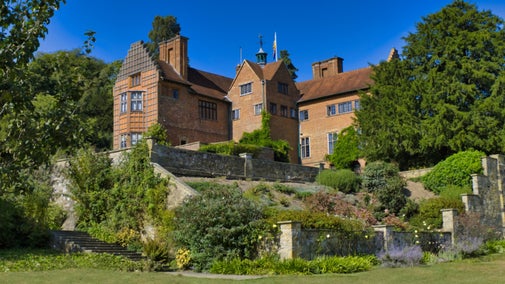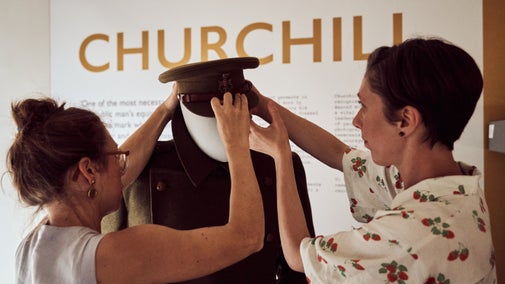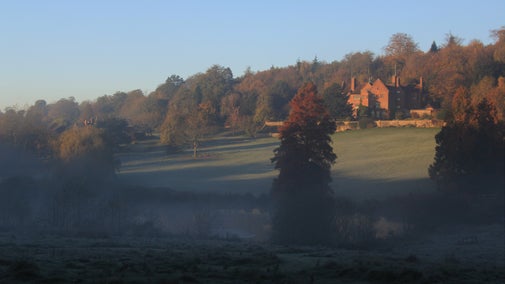
Chartwell's collections
Explore the objects and works of art we care for at Chartwell on the National Trust Collections website.

Learn about the house that Sir Winston Churchill, one of Britain’s best known leaders, bought for his family. It has been arranged and decorated as it was in the 1930s. Make your way through rooms that have been displayed as if the family have just left them. Explore the museum rooms filled with gifts to the Churchills, and see the personal possessions that Winston and his family kept here.
From 3 to 27 November, the house is closed for Christmas preparation and winter conservation work. Selected rooms in the house will reopen to visitors on Friday 28 November until 4 January (except Christmas Eve and Christmas Day when we are closed). Timed entry tickets to enter the house will be available on the day from the Visitor Centre on a first come, first served basis. For more information please have a look at the Planning your visit to Chartwell page.
Discover the house that Churchill called home, where he brought up his young family. As you make your way around the house uncover the home and family man behind the statesman.
These are the rooms you can explore on a self-guided tour with your house ticket during the main season, from March to October. For a guided tour of selected rooms including exclusive access to Sir Winston Churchill's bedroom, ask at the visitor centre about availability for a highlights tour or pre-book your place online. Highlights tours run Monday to Friday from March to October, excluding Bank Holidays.
Find out more highlights tours. (This information will be updated in 2026).
As we rely on our volunteers to help us open, on occasion some areas of the house might have to close for all, or part, of selected days. We always strive to open as much as we can and apologise in advance for any inconvenience caused.
During the Christmas period, 28 November 2025 to 4 January 2026, selected rooms of the house will be decorated for Christmas and open to visitors on a self-led visit or through pre-booked guided tours. Other rooms in the house will remain closed for conservation work until 28 February 2026. Please note, we are closed on Christmas Eve and Christmas Day.
Timed entry tickets for self-led visits will be available from the Visitor Centre on a first come, first served basis on the day. These cannot be pre-booked online.
Guided tours run on Monday–Friday, 2–23 December. Tickets for guided tours must be pre-booked online or by calling the central booking office. There is an additional fee.
Find out more about Churchill's Animals: Guided tour of Christmas in the House at Chartwell including the link for pre-booking your ticket.
This room is open during the Christmas period, 28 November–4 January, excluding Christmas Eve and Christmas Day.
The first room you will enter on your visit to Chartwell, is the sitting room which is laid out as it was in the years before the Second World War, although was later used as a bedroom by Lady Churchill. On sunny days you can also head out onto the 'Pink' Terrace, which provides the panoramic views across the Weald of Kent which Churchill fell in love with.
Don't miss: Winter Sunshine, Chartwell (c.1924) by Winston Churchill. Entered anonymously in 1925 into a London exhibition for amateur painters, it won him first prize.
This room will reopen 28 February 2026.
Once used as part of the nursery wing, before becoming Sarah Churchill’s bedroom, the room has now been redisplayed to tell the story of family life at Chartwell as a whole. It is decorated with wallpaper recreated from the 1960s design originally chosen by Clementine for this room when it was her dressing room, and today shines a light on the lives of Diana, Randolph, Sarah, Marigold and Mary Churchill at Chartwell.
Don’t miss: After Churchill's bedroom, the room also boasts one of the best views of Chartwell. You'll be able to see Chartwell from a new angle, over the orchard and to the Kentish Weald beyond.

This room will reopen 28 February 2026.
A place of calm with its duck-egg blue colour scheme and high barrel-vaulted ceiling, Lady Clementine Churchill spent many hours here, dealing with her correspondence and the household accounts at her writing desk.
Don't miss: One of the last photographs taken of Sir Winston Churchill stands on the desk in Lady Churchill's bedroom, to be found next to a photograph of their much-loved daughter, Marigold who died in 1921 aged just two years old.
This room is open during the Christmas period, 28 November–4 January, excluding Christmas Eve and Christmas Day.
A place to meet as a family and their guests, the drawing room is a light and airy room looking out over the garden. Churchill was fond of playing bezique in here and the card table beyond the sofas is still set up for a game.
The inscribed book collection in the drawing room consists of 898 titles in some 920 volumes. They include inscriptions from friends, family and well-wishers along with presentation copies from authors who were friends and colleagues. The changing display highlights some of the most unique inscribed books in the Chartwell collection.
Don't Miss: Charing Cross Bridge (1902) by Claude Monet, this was a gift to Churchill from Emery Reves after the Second World War.
This room is open during the Christmas period, 28 November–4 January, excluding Christmas Eve and Christmas Day.
Used by both Churchill and his research assistants, many of the books in here were received as presents and many more bought to aid in his work. It also served as a waiting room for those who had travelled from London to visit the Churchills, including those who came in secret to bring Churchill top secret information, in the years leading up to the Second World War.
Don't miss: Bronze bust of American President and wartime ally, Franklin D Roosevelt.
This room is open during the Christmas period, 28 November–4 January, excluding Christmas Eve and Christmas Day.
The organisational hub of Chartwell, the secretaries’ office, was opened to the public for the first time in 2020. Created using archive photographs and historic inventories of the secretaries' office, the room is dressed as it would have looked in the 1950s. Once a hive of activity, it's from this room that Churchill's dedicated staff would have fielded calls from key political figures and produced endless correspondence.
Don’t miss: Have a go with a phone exchange and flip coloured switches to hear more first-hand accounts from the Churchill secretaries.

This room is open during the Christmas period, 28 November–4 January, excluding Christmas Eve and Christmas Day.
The circular dining-table and armchairs to be found in the dining room were designed especially for the Churchills by Tilden and manufactured by Heals. The fabric on the chairs is an arum lily design which complement the vivid green curtains surrounding the room. This was the room where the Churchills entertained close friends and family, as well as hosting lunches and dinners for some of the biggest names of the twentieth century.
Don't miss: The Golden Rose Book, commissioned in 1958 by the Churchills' children to record the various golden and yellow roses in the Golden Rose Avenue created to celebrate their golden wedding anniversary.
This room will reopen 28 February 2026.
The museum room houses some of the most remarkable objects in Chartwell’s collection, from Churchill’s Nobel Prize in Literature to the 'Wanted' poster, with a £25 bounty on Churchill's head, from when he was a fugitive prisoner of war in 1899.
Don't miss: Churchill’s Honorary American Citizenship. He was the first person to be given this honour and one of only two to receive it during their lifetime, the other being Mother Theresa. It is one of the few documents in the world that connect both Winston Churchill and President John F. Kennedy.
This room will reopen 28 February 2026.
Churchill’s iconic uniforms are displayed in the newly restored Uniform room at Chartwell. The space has been returned to its 1930s appearance and now features a permanent exhibition, Churchill: Image and Power, which explores how Churchill used clothing to shape his public image.
The uniforms, all worn by Churchill during his public life, are displayed on customised mannequins that reflect his posture and presence. Archive footage and easy-to-read interpretation help to bring Churchill’s story and personality to life.
This room will reopen 28 February 2026.
What was once Lady Churchill's bathroom and dressing room, the ante-room on the first floor has since been converted to display an international collection of porcelain and memorabilia, including some of Churchill's most prestigious medals.
Don’t miss: The Public School Fencing Competition Medal. One of the few items on our collection that relate to Churchill’s schooling and adolescence, Churchill later referenced his victory in this competition as one of his proudest moments.
This room will reopen 28 February 2026.
The study was Churchill's workshop, which, apart from during the Second World War, he used constantly for 40 years, becoming the heart of Chartwell. He found it easiest to work standing up and would dictate to a secretary sat at the large mahogany writing-desk you’ll find in the middle of the room.
Don't miss: The Union Flag, hoisted in Rome on the night of 5 June 1944, the first British flag to fly over a liberated European Capital.
This part of the house will reopen 28 February 2026.
Don’t miss: The Duke of Marlborough (1650-1772) after Adriaen van der Werff. Following restoration, this portrait of Churchill’s ancestor and hero is on public display for the first time since Chartwell opened in 1966. The display celebrates the 375th anniversary of the birth of the Duke of Marlborough as well as the treatment of this painting which has enabled it to be publicly displayed for the first time in its long history.
The portrait was given to Churchill to raise his spirits following the Fall of Singapore in February 1942, which he described as the “worst disaster” in British history. Churchill wrote a one-million-word biography of the Duke, one of the works for which he was awarded the Nobel Prize in Literature.

Explore the objects and works of art we care for at Chartwell on the National Trust Collections website.
To help us protect the precious collection at Chartwell, you'll need a timed ticket to enter the house. Discover how to get yours and find out more about planning your visit.

Following a major conservation project, made possible by generous donations and supporters’ legacies, the Uniform Room at Chartwell has been transformed to showcase Sir Winston Churchill’s newly restored uniforms. ‘Churchill: Image and Power’ explores how Britain’s wartime Prime Minister became one of the most recognisable figures in history.

A guided house highlights tour is great way to discover more about Chartwell’s stories. Choose from four different themes focusing on specific elements of Chartwell’s history.

Enjoy the views that the Churchills chose Chartwell for, and explore the garden they created and loved, from Lady Churchill’s Rose Garden, to the Walled Garden Sir Winston helped build.

Chartwell’s estate and surrounding countryside offers far-reaching views across the Weald. Walk in the footsteps of one of our founders Octavia Hill when you explore Mariners Hill.

From tasty treats and hot and cold dishes, to souvenirs, gifts and Churchill memorabilia, you'll be spoiled for choice in the Chartwell café and shop. Why not treat yourself?

Discover more about the extraordinary life of Sir Winston Churchill in this permanent exhibition at Chartwell, including five must-see items from the curator.
